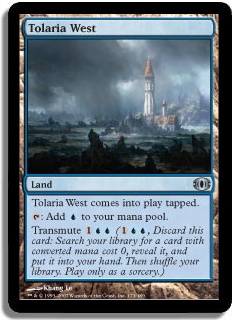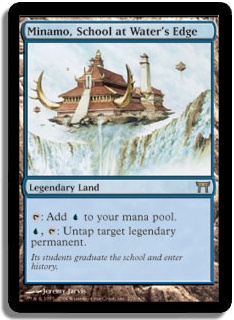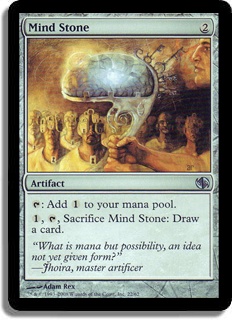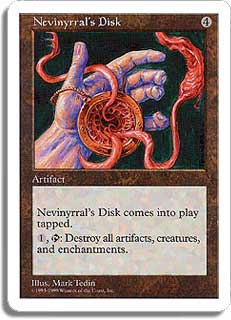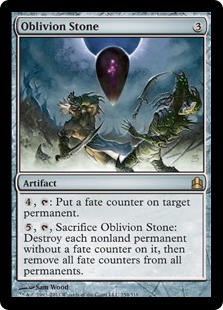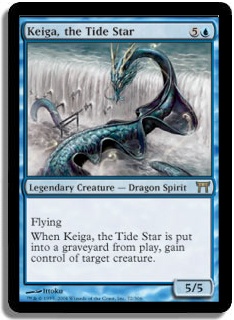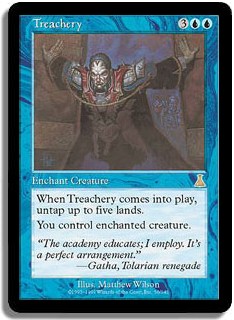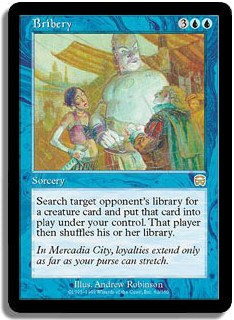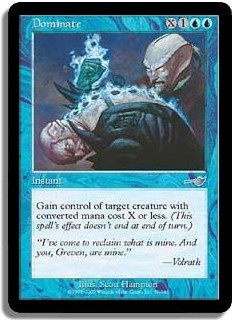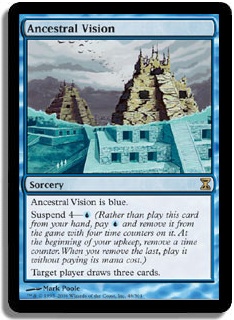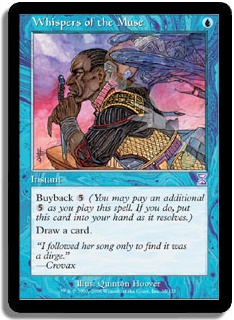Dear Azami, I’ve been having a lot of trouble with my recent Zedruu deck, so I’ve been trying to switch over to Talrand, Sky Summoner. He’s an absolute blast! I’m just not having an incredible amount of success with my build, and I was hoping you could give me some pointers. The deck is just an absolute blast to play. There are about sixteen draw cards which two-for-one and get me a flyer with my commander. The deck is just…lacking something, and I can’t quite figure it out. The win cons are just getting an army of Drakes and the few beaters in the deck (Sphinxes, Kozilek, Stormtide Leviathan). Here is the list: Commander: Talrand, Sky Summoner That’s the list. I’m so lost on how to properly build a mono-color deck. I feel like my land base is WAY off. Ideally, I think I need to find a way to take infinite turns and win that way. Like I said, it’s an absolute blast to play. It’s just suffering from the fact that I’m still new to the format and am having trouble making a mono-color build. Budget-wise I can pick up anything $20 or under. The more expensive stuff is still feasible, but it really has to be worth it. For an idea of my meta, people play Child of Alara, Progenitus, Sigarda, Rafiq, and Karador among others. Please help! |
It’s kind of funny what got me so intrigued with this decklist. My illustrious editor has wanted for us lazy Commander writers to get on those M13 Commanders and work on decks for a while now, but what can I say, we’re easily distracted. What was I saying? (Oooh, squirrel!)
Talrand intrigues me the most because it actually profits you to play all of the one-mana cantrips, which really changes the math on what an appropriate number of lands is for a Commander deck. I start with a catchall number generally—I slot 37 lands in, plus a few mana artifacts that tend to always be present (Sol Ring, Expedition Map, and Mana Crypt for me, though it’s entirely understandable if the hefty price tag on the latter is out of reach), which means that I conceptually start at 40 and go from there.
Some work their way higher up—you start adding cards like Insurrection but not a lot of acceleration to cast it with and suddenly the mana count needs to be higher. The better you are at figuring out how to get multiple lands out of one card to do that with the better off you are. But once you’re playing all the one-mana filter cantrips, that number creeps downward, not up. After all, the ancient rule of thumb has been that for every two cantrips you add to a 60-card deck, you can shave one land and still operate normally. I was made curious by trying to figure out what the correct number of lands was in this deck, and the more I thought about it the more interested I was in the deck, trying to figure out what the puzzle piece you were missing was.
I think I hit upon it by trying to figure out how you make do with so few creatures in your deck. Looking at it, it made sense to me only in the context of playing Talrand on turn 4, then spending turn 5 casting cantrip after cantrip and summoning a horde of Drakes from the sky, then protecting that board position and using it to overwhelm the opponent. A reasonable plan, but worth noting that it is one that presumes that tapping out on turn 4 to play your commander is not going to result in it just immediately dying. That assumption was part of the context I was missing right off the bat. You mentioned what your metagame is like, and in so doing it became apparent to me that we are talking about a metagame with more sweepers than individual pinpoint removal spells, so a quick Talrand wouldn’t earn immediate ire.
What happens as you go about the plan, then, is the important trick to making it all hang together; the missing ‘something’ that makes the deck click. It’s weird to figure it out, but this is an aggro-tempo Commander deck, and thinking about it in that context made me immediately compare it to my Animar, Soul of Elements deck…which I have since made myself take apart because it stopped being fun just casting piles of card advantage things and attacking entire Commander tables to death by turn 6. Talrand fits a similar context, though not the absurd power level that Animar has built in, and looking at it from that perspective made it easier to understand what the deck is trying to accomplish and then pursuing those goals.
Animar works in a way that is not immediately intuitive because the game plays out in distinct phases. It tries to play the same game over and over again as consistently as possible, and those games always have inflection points: intentional phase shifts where your priorities change and the thing you’re pursuing is of a different character than it had been earlier. Putting that in the context of your Talrand deck, I want to build it to play as follows:
- Pre-game. Turns 1-3, where (as needed) you establish the board. A little bit of setup may be needed to ensure that the fourth land drop is made on turn 4, and cantrips will be played accordingly but held otherwise.
- Establishing Shot. Turns 4-6, where Talrand is summoned and then Drakes are Sky Summoned by playing cantrips as cheaply as possible on turns 5 and 6 to establish a board presence.
- Defense. After an initial board presence is made, the focus shifts to defending yourself, be it by pushing things out of the way so that your assault can continue or by deploying countermagic or even evasive action to keep your position on the board as it is.
You also need to have something effective to do when Plan A doesn’t work out, which in the case of your current build is the fatty deployment plan. Talrand, after all, would be happiest if you have no creatures in your deck or nonland permanents; you don’t get a free Drake when you cast a creature or drop an artifact onto the board. Sometimes, though, things go south. What I referred to as “defense” is only such in the perspective of tempo-based defense, not actually effective defensive measures, and there are going to be times when you need to take a true defensive stance rather than an aggressive posture. An actual defense to be mounted is important to have as a Plan B so that after you’ve exhausted the enemy’s resources and defended against whatever the problem was, you can go back to Plan A and do what you intended to do all along.
That means, among other things, you’re too countermagic-heavy. Yes, you can cast a counter and get a Drake for your trouble, but ultimately that’s just trading one-for-one with one of three opponents. While this can seize the tempo, it’s not what you want to be doing in the establishing turns of the game but more of a defensive plan afterwards…and even then, not a perfect one. It’ll be better to look at the overlap between what each of the players are doing and use more potent effects to deal with all of it instead of keeping up mana to prevent it from happening.
Starting with the land base, there are improvements you can make, and I had to actually put your deck together in Magic Workstation and take test draws of it to figure out what was the right number of lands to include. 37 felt like too many, but the fewer you play in favor of cantrips instead, the more you have to worry about drawing the cantrip and needing to burn it early instead of playing five of them on turn 5 and getting ten power in Drakes because your ideal plan happened to work exactly right.
Settling on 35 lands seemed like the sweet spot, especially given the presumption that you have the advantage of some element of a free mulligan. Under 35 and you start to see too much going on early to cause you problems, so I stopped comfortably there and made room for two more cards without affecting the deck’s ability to draw well early. Drawing well late should be well covered. After all, your cantrip plan doesn’t actually spend cards to make Drakes, but it improves your hand for going forward with the rest of the game.
35 may sound low for a deck that plans to cast ten-drops at some point, but remember when you are playing cantrip after cantrip you will find more lands, so you actually have to concern yourself with flood more than you’d think. Thus, it is important to get more effect out of your land slots where possible. That includes shrinking those slots to the appropriate number, and I was comfortable dropping to this number but no further.
OUT: 10 Islands
Two of these slots are substituted elsewhere, but that gives us eight replacements. They are, to frequent readers, somewhat predictable, so I’ll gloss over this to save critical brainpower instead of explaining for the hundredth time why Dust Bowl is a good card that will lead to a righteous beating from an angry mob armed with torches and pitchforks.
IN: Tolaria West, Minamo School at Water’s Edge
The other six lands are going to be colorless, which leaves us with 29 total blue sources in the deck. This will make it harder to play five one-mana cantrips on turn 5, but that is already made hard by the fact that you have to draw five of them and there aren’t that many of them.
IN: Miren, the Moaning Well, High Market, Dust Bowl, Winding Canyons, Academy Ruins, Riptide Laboratory.
Moving on to the actually interesting part about the deck, it’s time to have a look at the artifacts. This gives you the most room for defensive measures, after all, since blue is actually pretty abysmal at defending itself using only in-color solutions. Taking greater defensive access to artifacts will give the deck more of an ability to survive tough situations where it doesn’t start off immediately ahead and someone else doesn’t happen to take care of the problem for you, and thus improve that Plan B option which your actual creature base seems dedicated to.
You’ll notice I added an Academy Ruins. You have a Mindslaver in your deck. We’ll have to do something about that.
OUT:
Mindslaver — Anyone capable of recurring Mindslaver on people is someone I do not want to be around, just in general concept—it’s really uncomfortable when that starts happening and bad enough when it happens just the once. Mindslaver doesn’t really effectively further your goals, while with the additions we’re adding here Academy Ruins will prove quite valuable, so between the two I’m keeping the land in the deck and taking the expensive (but cool) Slaver out.
Darksteel Ingot — Mana rocks that are indestructible are good, but this does nothing to speed up Talrand, which means while it’s good it is off-curve for your plan and bears replacing either with something entirely different or a mana rock that actually helps play Talrand a turn earlier.
Venser’s Journal — This is a Spellbook effect you don’t need (I didn’t even add Reliquary Tower, which is a Spellbook stapled to a land) and a very expensive, very slow life gain card that you just don’t need. When I said I wanted to improve your defenses, this is not the way I was thinking of doing it.
Tormod’s Crypt — Considering you don’t really use your graveyard, this not being the cantrip version (Relic of Progenitus) is a serious issue that bears addressing. You like cards in your hand, after all, and the mana cost to upgrade is pretty minimal all things considered.
Elixir of Immortality — If I saw something worth protecting, I’d be down with this and say it makes sense. As it is, the library protection side is covered by having an Eldrazi in your deck, and the life gain is again not how I would like to see us go about defending ourselves.
Extraplanar Lens — High risk, high reward, but in this case the risk is just too high. If you play it on turn 3 and it lives, you have the ability to play Talrand and a pair of cantrips the next turn; if you play it on turn 3 and it dies, you can’t even play Talrand for another two turns and the blow is crippling to your tempo. The more expensive ones are worth including on their own merits because they’re all upside, but this is a lot of risk in a deck that has to be very risk-averse in this regard.
Adding back in, we’ve already hinted at a few, be it in the lands department or naming upgrades. We add in the following:
Relic of Progenitus — Pure upgrade to Tormod’s Crypt and playable at no downside because it is a cantrip. Tormod’s Crypt can only really be justified if you know exactly who you’re playing against right away, while Relic of Progenitus is pretty neutral and thus good regardless of whom you play against since at the worst it cycles when useless.
Mind Stone — What can I say, I really like Mind Stone in general to begin with, and in Talrand it is on-curve to accelerate you to a turn 3 Talrand but isn’t dead later in the game and is not vulnerable in a way you have to care about to those pesky sweepers like Austere Command that get everything that matters at the most inconvenient moments. It won’t be collateral damage, and it has the potential to really improve your game plan when you have it to start off, so it’s basically awesome.
Nevinyrral’s Disk, Oblivion Stone — The main reason to recur anything with Academy Ruins, these are the sorts of defense I was thinking of when you need to stall and outlast through opponents who have gotten far enough ahead that you have to one-shot the board instead of burn card after card trying to get back to parity and then ahead. Nevinyrral’s Disk also has awesome ramifications with Capsize; some of my fondest (evil) memories of playing Magic in 1997 involve the Capsize-Disk lock that sometimes accidentally happened to wipe out any chance of the opponent getting back into the game.
Vedalken Shackles — An expensive inclusion but a very high-power one, and the reason you see Miren and High Market appearing in the mana base. Stealing and then sacrificing creatures is going to be a defensive theme, one that is all the more awesome due to the fact that when it’s not a purely defensive move it’s a highly effective aggressive one.
Leonin Bladetrap — A bit of an oddball, but in this particular case it allows you to defend yourself from a horde of small creatures with some surprise value, given that it is not exactly a card anyone really expects to happen to them when they attack with a small horde of tokens or an Elf army. I went looking for sweepers that would leave your cohort of Drakes alone and happened upon this old gem with fond memories of Limited blowouts. While it won’t be awesome in every game, it will still be useful—you don’t have to be the defender to make it work, after all—and the games where it’s great you’ll have it as something you can recur with Academy Ruins just like the other defensive additions.
Usually I move on to spells next then creatures, with the creatures being the ‘big finish,’ but in your deck it’s the spells that are the final flourish. Creatures are here mostly to defend yourself, and some additions will be made to up the critter count since I think as permanents they are more effective at doing so than single-use spells would be. All told, I switched over five slots between the lands and the spells, and we’ll make a few cuts to better streamline the plan in addition to bolstering it. I can’t reasonably justify Arcanis the Omnipotent in this deck because you definitely don’t have a card flow issue and he’s just kind of slow, clunky, and doesn’t do what you want to do: play spells to get tokens.
OUT:
Augury Owl — Just too low-impact for my liking. Scrying is okay but not great, and the 1/1 body doesn’t make it worth the lost card in order to do so. Trying to think of something better, I hit upon a lot of options very quickly and happily gave this the axe.
Arcanis the Omnipotent — Just looking at how this deck plays out, is playing a six-drop on turn 6 a really good plan? Not really, since you want to either further advance your Drakes or actually do something to defend yourself, be it play a counter or drop a defensive countermeasure into play. Arcanis may tap to draw cards, but he’s pretty lousy as a blocker. We want more high-impact threats that immediately sway the board, and we’ll have plenty of cards with no problem almost no matter what we do.
Sphinx of Jwar Isle — As a flagship fattie, Sphinx had some good press in its day since big shrouded meanies are kind of hard to handle. But as with Arcanis, the sudden six-drop doesn’t make that much sense, and while the body is considerably better on both offense and defense, I’m just not convinced it’s the right card for you.
Jin-Gitaxias, Core Augur — Ten mana is an ambitious amount to reach, and once you get there and play this, what do you get? In an ideal universe, one opponent drops their hand and then you draw seven cards, and if you’re able to defend him against everyone else the game becomes trivially easy. That’s an awesome scenario, but there’s a lot of ‘what if’ involved. The worst-case scenario is you pay ten and it just eats a removal spell since a four-toughness creature with an amazingly high bright red blinking threat index will require addressing and will be addressed. You’re not cheating with him, which means he’s just a support card, and he’s actually not very good as a support card.
With four cuts, we get to add in nine creatures after shifting from the other sections. Some of these will be obvious; the good stuff cards got that name for a reason, after all, and blue’s theme of borrowing or outright stealing creatures is one that is worth pursuing further to enhance your tempo-oriented defense.
Wurmcoil Engine — If you’re going to defend yourself and do so in a way that is both robust and durable, Wurmcoil is your…engine. Lifelink on a 6/6 is the kind of life gain I can get behind—Venser’s Journal doesn’t gain life anywhere near as hard as this, and the impact a Wurmcoil has on the board when you’re playing defensively is quite impressive. The deathtouch side of things makes sure you can answer not one but two significant threats, and if there are threats coming your way the lifelink side is a solid buffer to keep you afloat against opposing pressure. But add the durability factor—even after it’s done its job defending and gaining life, you get the two tokens that continue to do that job—and it’s the sweet spot of card you want to grab hold of.
Keiga, the Tide Star — There is a reason that if you’re going to play tap-out control you drop Keiga as your Dragon. Even if it dies, the worst thing that can happen is still a pretty awesome exchange for your side of things, as your defender is replaced with whatever the next best defender is or the most potent threat that you had to worry about facing down. Keiga is a big blue stop sign that is both threat and countermeasure and is the kind of critter I really want to tap out on turn 6 for even if I could make a whole flock of Drakes instead.
Augur of Bolas — Considering how spell-heavy your deck is, Augur of Bolas is a considerable upgrade over Augury Owl, since instead of window-shopping you get to buy the right card. Add to that the positive interaction with Riptide Laboratory and it’s downright amazing. The Lab was added to help try and keep Talrand affordable in those grindy games by potentially saving him from destruction a few times and resetting him to a four-mana version instead of a ten-mana one, but with the few Wizards we’re actively adding you still get considerable bang for your buck.
Snapcaster Mage — As awesome as it gets when you want to play spell after spell since at the very worst you’ll be able to snap back a second use of Ponder or some such, but in the games where it’s amazing it lets you pick your choice of defensive measures or aggressive tools to work with, just like he’s currently doing in Standard. Also a Wizard for the Riptide Laboratory, which is pretty disgusting when it happens, but even without that interaction this is just the right recursion effect and thus the best ‘Tutor’ you could hope for in the color. It says 1U: Tutor for the best spell you’ve already played and go ahead and cast it. (And adds a body, just because.)
Sower of Temptation — Another Wizard and thus another means to potentially recursively steal and eat creatures if you get going in a grind-oriented mid game. I like adding grind aspects to decks just in general principle, and this is both a moving part that lets you potentially recur that grinding advantage aspect and an awesome early play or defensive countermeasure. Basically perfect for whatever ails ye, so long as you can protect it or trash the thing you steal, and you’re good at doing both those things.
Beguiler of Wills — Really hard to take meaningful threats for you since you don’t have that many creatures to begin with, but you start by stealing something small and then work your way up the food chain and it’s a very credible card…for a five-mana 1/1. While it dies in a stiff breeze and has obvious limitations as to how effective it will be, it taps to give you free stuff at no mana cost and does not ever give them back.
Callous Oppressor — Especially considering you get to choose who names the creature type, this can keep problem commanders at bay or otherwise just be able to indiscriminately tap and steal things because the opponent you asked was kind enough to say Antelope as the creature type instead of Goblin. Not quite as good as Vedalken Shackles—creatures really are vulnerable card types—but just as capable of providing that same defensive / tempo measure we’re looking for.
Sphinx of Lost Truths — I like this as a five, and when that’s what you want to do it’s awesome as a seven, like having an Arcanis the Omnipotent that you can be certain actually gets to fire off a shot of card draw at least the once. It’s also a better defender since it flies and has bonus toughness, and originally this was the Sphinx I thought you meant when you said you had Sphinx of Jwar Isle in your deck. The cards must flow, and this card does that especially well.
Aboshan, Cephalid Emperor — Sure, it’s a little goofy. (Not ‘Lorthos the Tidemaker’ goofy, but pretty goofy.) It’s also a solid defensive countermeasure able to prevent entire swarms from attacking and can potentially able to soften up a defender from being able to block effectively. Your threats may fly and thus not care about blockers on the ground, but there are certainly going to be other opponents who you can prompt into beneficial attacks by dangling a sudden flood upon their beloved enemies.
Even the other side can be useful, although it’s almost immediately forgotten about—Aboshan plays not just flood-maker but one-man Opposition while he’s at it, immediately online as an Icy Manipulator even as he threatens to muss up attacks and blocks all over the place. Since it has excellent political use and solid defensive measures, it seems to fit the role you’d selected for flagship creatures like Stormtide Leviathan, thus I thought of giving him a slot. I do so only infrequently and am glad to see him get one today.
This lets us move on to the spells, where we retool things considerably to alter your defensive stance as well as streamline the spells-into-Drakes side of things.
OUT:
Cancel, Counterspell, Dissipate, Negate, Scattering Stroke — Trading reactive counterspells for your opponent’s spells one-for-one needs to have some serious upsides in order to be worth doing. The ‘upside’ being ‘Counterspell only costs two mana!’ is not a sufficient upside. I don’t disagree with the fundamental concept, and in fact pull five out and put seven back…but the upsides of those seven are drastic improvements over these.
Careful Study — I’m down with the one-mana cantrips, but Careful Study actually puts you down a card, not at parity or ahead. Frantic Search is the same card with the benefit of actually being free, so I’m down with it as part of your plan, but for something you actually have to spend mana on I’m going to stick to cards that actually replace themselves instead of merely filter.
Gravitational Shift — I point to this one as more cute than effective; it’s most useful as an aggressive tool to pump your fliers, but I don’t think there’s much of a need for a card that does that when you can streamline the deck to simply output more fliers more consistently. As a defensive tool, I prefer actual effective defensive countermeasures, and we’ve already built those in instead of relying on this to blunt attacks.
Polymorph — Trading a Drake for a chance at something titanic was cute but not really helpful.
Mystical Tutor — With there being enough redundancy in the deck, the Tutoring power is not as important—you’ll find a lot of whatever you need with your existing card draw and card filtering mechanisms. It can enable finding that one-of Evacuation, All is Dust, or Fabricate for Oblivion Stone, seek out just the right card when you want to close out a game with Walk the Aeons, or find that Rite of Replication to cast with kicker. But there’s enough redundancy of effects that just another good cantrip would probably serve quite well also. While always replacing itself and making a Drake, I’m not sold that this is really proving helpful to this deck.
Mind Control — I like the effect, but I dislike the part where you don’t untap five lands. Will be replacing this with Treachery because some of the Urza’s block cards they made were dumb.
Jace’s Ingenuity — We can do better than this.
Time Reversal — Getting seven cards in your hand is a good thing. Giving everyone else seven cards too is a bum deal you shouldn’t be making.
Trade Secrets — Everyone knows the game is “I get four, someone gets two.” It’s fine for that, sure, but there’s better card drawing around before hoping your opponent makes a mistake and gives you eight cards so they can have four. There’s also some strong overreaction when people see a player cast Trade Secrets, since it is so ripe for collusion where two players get enough goodies to win the game and the other two get to watch and die. The really cute trick, Mindslavering someone before making them the brain that decides how many cards you get to draw, is no longer an option.
Peer Through Depths — More powerful than Impulse but more restrictive, since you can’t ever pick a land, creature, or artifact, and there will be times you’ll wish you could do each of those.
Quicken — I don’t, frankly, see much of a use for this. The number of impactful sorceries is limited and thus the ability to play them with flash is not really happening here. It’s a one-mana cantrip, it’s true, but you can still do better than that.
Propaganda — As with Gravitational Shift, is this actually going to blunt an attack or just threaten to tax one? My definition of defense is different than this card’s. Since this does absolutely nothing if someone decides to pay the tax and choose you as the enemy of interest, it’s mostly there to disincentivize that decision, but in the cases where it’s correct for them to reach that conclusion, they simply will.
Switcheroo — For gaining control of a creature, you can do better than this. If, instead, you want to mess with two other people entirely…cool! But I suspect that’s not the motive here.
Unsummon — For starters, I’m not convinced this is an effect you want. I’m willing to be convinced, however, and in that case it seems clear that if this is what you want there is a better version you could have instead.
Talrand’s Invocation — You’ll get two Drakes out of a cantrip and the three-mana savings instead, so this spell is just not that impressive even if it is, on the face of things, a good deal.
Jace, Memory Adept — If this were Jace Beleren, I’d entirely understand what it was intended for in your deck, but instead it’s Jace 3.0 and he just strikes me as a little too hard to defend for not quite a whole lot of benefit. The politics of being able to share won’t keep him around, and it’s very clear that this Jace is all deals for you and no deals for anyone else. Some people will say ‘at least it’s not Jace, the Mind Sculptor,’ but that won’t actually prevent anyone from attacking your Jace to prevent him from giving you cards. If all you wanted to do was make enemies and draw cards, Rhystic Study would do much more for you much more reliably.
Having taken twenty out, we only have room to put seventeen back in since we’ve moved three slots over to the creature department. We want to replace some counters and some card draw, but otherwise we need to find better defensive means than the ones which have been taken out.
Treachery — Mind Control, but free. Rather a ridiculous card, but one that is obviously in keeping with what you’re trying to accomplish.
Bribery — I don’t add this often, but it seems exceptional in this deck since you want big aggressive threats and you like spells since they make you Drakes. Bribery can really put you in the power seat. I’m imagining an exchange where you play Talrand on turn 4 then lead with Treachery on the best threat present, Frantic Search to work your hand and make a Drake, then Bribery an opponent and get the best threat possible and make a Drake. Games that go anything even close to that will be awesome indeed, which makes Bribery your card of choice though I don’t often like it (and in fact intentionally don’t own a copy).
Dominate — Instant-speed creature theft is a pretty awesome thing to get access to, and while this is very expensive for a high-end threat like a Titan or Praetor, you have the ability to reach for normal creatures without any augmentation and Gilded Lotus, Caged Sun and Gauntlet of Power for grasping those things otherwise outside your reach.
Snap — Unsummon and untap the lands you spent to play it. I had to decide between this and Pongify as the defensive spell of choice and am still not entirely confident I’ve picked correctly, but there are enough problems that Pongify doesn’t solve that people will try and pull on you that I’m comfortable picking Snap on the fact that it is free for all Drake-making purposes.
Cryptic Command — Part awesome counterspell when we need to make the counterspells more awesome, part defensive countermeasure that can at least temporarily deal with whatever your problem is by bouncing it or preventing an attack. While there is going to be a problem to some degree in that all of the answers we’re potentially looking at are only temporary answers to the problem at hand, Plan B is to use them against the opponent by outright theft, so that shouldn’t be too big of a problem. This is the perfect tempo card for a deck that is clearly going to be mindful of making tempo-positive plays since it is full of options (and even a cantrip!) and thus can fit the form of whatever answer you need it to be right now.
Wash Out — There will be times when you get in deep trouble and really want to reset the board but don’t want to lose your efforts in Drake-making in so doing. Wash Out lets you target some of the board instead of all of it and makes a pretty massive impact in so doing. By selecting one color it doesn’t really miss anything and is entirely capable of resetting a mono-colored opponent to ‘just lands in play’ (okay, lands and a Divining Top, fine!) and even polychromatic opponents like your metagame seems full of will still have a lot of overlap (so you can Wipe Out multiple players with the same effect) and strong bias for the major threats in play (Primeval Titan + Avenger of Zendikar and all the tokens, for example).
Submerge — Tucking a commander is a good deal. So is getting to cast Submerge for free and getting a Drake out of the deal, meaning that I have a new ridiculously awesome vision… Play that Talrand, Treachery the best threat, Snap something that needs to go, Frantic Search to improve your hand, Submerge someone’s commander, and Bribery them to shuffle it in as you take the most awesome thing. Plus two killer threats and four Drakes on the turn equals many sad opponents.
Hinder — Tucking commanders is a very good benefit to add to a counterspell, so Hinder is special enough that I’m interested in seeing where this goes, while good, old-fashioned, regular Counterspell was boring.
Time Stop, Mindbreak Trap — These two are on the list of ‘How do you deal with (add impossible situation here).’ Since they effectively exile the threat rather than let it resolve and can both clear a full stack of whatever ridiculousness may be going on, uncounterables like Obliterate are still solved by them and there is no chance of getting back whatever it was that made you respond. Time Stop has enough flexible utility that it’s not ‘just a counterspell,’ since it can counter a player’s even having a turn or counter a lethal attack phase that didn’t go the way you wanted it to, placing it in both the Counterspell camp as your most final of all possible answers to any problem and the defensive measures camp.
Commandeer — I like free counters, which Mindbreak Trap can sometimes be (but it doesn’t come up that often). Commandeer is expensive to hard cast and expensive to make free, but there is a huge upside to doing so—not only does it potentially deflect a spell but it gains control of it as well, making it an awesome response to card drawing like Promise of Power or an opposing Bribery. There’s going to be a subtheme of ‘don’t counter that, take it!’ and Commandeer does that quite awesomely.
Desertion — Don’t counter that creature… Take it! For some reason this works on artifacts too, so I’m just sort of confused, but hey, I’ll take it.
Spelljack — The version of Desertion that works on spells of any sort and includes weird side benefits. Like Time Stop and Mindbreak Trap it exiles things, so as long as you don’t cast it yourself it remains off-limits for anyone trying to recur it. It’s just good at defending yourself and advancing the board, which is the kind of defensive measure I’m interested in with Talrand. Since it is highly tempo-conscious while also being solid for card advantage purposes, it has a lot of swing going for it.
We now have just four slots left and need to put some cantrippy card drawing back in to replace those parts I’ve taken out. While I did quip that Rhystic Study could go in the deck, I actually don’t like that card for strategic ‘don’t murder me, guys!’ purposes. Playing a Study on turn 3then Talrand on turn 4 is going to get your stuff grudge-killed so fast it’s not funny, and while Rhystic Study is so powerful that you have to consider it anyway, I aim to avoid cards that polarize the board against you. Opponents deciding they absolutely, positively must kill you because of that card and continuing to think that long after the Krosan Grip came and destroyed it is not the game playing experience I’m looking to foster. The next most powerful card will do just fine at that job as well, after all, without getting you murdered for it.
Ancestral Vision — The only spell Tolaria West is able to find, though it’s worth noting Tolaria West was plenty good even when it was just Tutoring for the right land of your choice. Ancestral Vision in your opening hand comes off suspend just in time to make a Drake and fill your hand with three more cards so you can cast more of them and make more Drakes. This means we have yet another thing to add to the ridiculously awesome start of destroying your opponents and making Drakes, as we can add ‘draw three cards, make a Drake’ to that chain of events, totaling all of the major threats dealt with, two massive threats added to your side of the board and five Drakes for your trouble. Games that are anywhere even close to that level of awesome are going to be amazing, and since we keep adding more and more pieces that work like that, you’re going to find your turn 5s very fruitful indeed.
Whispers of the Muse — A very weak cantrip early but incredibly strong late, especially with a Caged Sun effect online. For six mana you draw a card and make a Drake, and you can repeat this as many times as you can afford to (or care to). For those games that don’t go quite as you’d wanted and you need to sit back defensively for a while with a Disk or O-Stone ready to go, Whispers of the Muse is a great setup spell for what you intend to have come next, since the follow through is always going to be blow up the world and build your own immediately. Stocking your hand will help make that a reality, and Whispers favors the patient, which sometimes you will actually need to be.
Flash of Insight — While it’s more expensive the first time, taking three mana just to draw a card, the ability to be expensive can potentially be a benefit as well, since there will be games where you have twenty mana available and in those games Flash of Insight is just going to feel like a Tutor for whatever you wanted to do. Add in the flashback option to a deck that doesn’t really do anything with its graveyard and you can have an excellent card selection spell that gets you two cards for the one you invest, and the two cards you get are as awesome as you can make them. Getting two castings off a single spell gets you two Drakes and is thus quite awesome—you can cycle it turn 3 to help make that fourth land drop and still have something worthwhile to do and contribute to the Drake-making out of the graveyard.
Deep Analysis — My ‘clearly better’ for Jace’s Ingenuity since it ultimately draws another card for another mana but has the option to be broken up into two chunks as-needed, adding flexibility of use as you get that extra benefit. Add to that the fact that getting cast twice makes twice as many Drakes and it’s not hard to understand why I reach for Deep Analysis, though it is often forgotten rather than included simply because the Commander card pool is so damn large. It’s also my version of Rhystic Study that doesn’t get you killed for playing it; you do in fact get a whole pile of cards, but you didn’t make anyone angry enough to turn against you. And for old, fond memories’ sake, I feel inclined to note just how awesome it is when a Fact or Fiction flips past a Deep Analysis. I haven’t seen it in forever, but it really is as awesome as it sounds.
I did wish I had room for one more cantrip, really wanting to add in Thought Scour since it’s surprisingly awesome at preying upon Mirage block Tutors that are often reached for. Picking off the Tutored-for card and drawing a card is a good benefit, and it also works reasonably positively in your own deck for setting up flashback cards or feeding something good to Snapcaster Mage. I also wished that things like ‘budgets’ didn’t exist because just like I felt Callous Oppressor was a good addition to the deck and so too would Old Man of the Sea prove quite awesome, but as an ages-old rare from Arabian Nights it’s unsurprising that it’s out of reasonable financial reach.
The absurdly high-powered version of this deck, after pouring the Miracle Gro of money on it, would have Mana Crypt, Mana Drain, Force of Will, and Old Man of the Sea in it, but I don’t think this is so critical that it requires any real thought or effort… Though Talrand would be quite awesome with a Mana Crypt to work with since that gives you not one but two effective Sol Rings for that crazy turn 2 Talrand draw. While you could potentially do something ridiculous with Mana Drain, there’s already plenty of ridiculous possible without it and it’s still ‘just’ a counterspell.
Putting it all together, we get the following:
Creatures (15)
- 1 Keiga, the Tide Star
- 1 Callous Oppressor
- 1 Aboshan, Cephalid Emperor
- 1 Sower of Temptation
- 1 Sphinx of Lost Truths
- 1 Kozilek, Butcher of Truth
- 1 Frost Titan
- 1 Stormtide Leviathan
- 1 Wurmcoil Engine
- 1 Consecrated Sphinx
- 1 Sphinx of Uthuun
- 1 Snapcaster Mage
- 1 Beguiler of Wills
- 1 Talrand, Sky Summoner
- 1 Augur of Bolas
Planeswalkers (1)
Lands (35)
Spells (51)
- 1 Brainstorm
- 1 Hinder
- 1 Nevinyrral's Disk
- 1 Treachery
- 1 Sol Ring
- 1 Time Stop
- 1 Whispers of the Muse
- 1 Sleight of Hand
- 1 Rewind
- 1 Impulse
- 1 Capsize
- 1 Serum Visions
- 1 Wash Out
- 1 Vedalken Shackles
- 1 Desertion
- 1 Frantic Search
- 1 Oblivion Stone
- 1 Gilded Lotus
- 1 Fabricate
- 1 Bribery
- 1 Proteus Staff
- 1 Leonin Bladetrap
- 1 Evacuation
- 1 Mind Stone
- 1 Snap
- 1 Submerge
- 1 Dominate
- 1 Fact or Fiction
- 1 Spelljack
- 1 Flash of Insight
- 1 Deep Analysis
- 1 Commandeer
- 1 Ancestral Vision
- 1 Gauntlet of Power
- 1 Think Twice
- 1 Walk the Aeons
- 1 Cryptic Command
- 1 Ponder
- 1 Relic of Progenitus
- 1 Expedition Map
- 1 Into the Roil
- 1 Mindbreak Trap
- 1 Rite of Replication
- 1 All Is Dust
- 1 Preordain
- 1 Blue Sun's Zenith
- 1 Darksteel Plate
- 1 Caged Sun
- 1 Gitaxian Probe
- 1 Spell Crumple
- 1 Visions of Beyond

As always, for participating in this week’s “Dear Azami,” you’ll be receiving a $20 coupon to StarCityGames.com. I know you said you figured anything under $20 would be easy enough to do, but I’m also hoping that a single Snapcaster Mage is potentially something you already own or can get relatively comfortably due to being just a rare from a recent Standard set. Most of the cards are still highly affordable—everything but the Snapcaster is under that high water mark, and there are only three other cards above $10, with half of the suggested alterations being two dollar cards or less. Here’s an itemized list of the additions made, for your consideration:
| CARD: | PRICE: |
| Leonin Bladetrap | $0.25 |
| Whispers of the Muse | $0.25 |
| Dominate | $0.39 |
| Aboshan, Cephalid Emperor | $0.49 |
| Flash of Insight | $0.49 |
| Sphinx of Lost Truths | $0.49 |
| Callous Oppressor | $0.75 |
| Hinder | $0.75 |
| Snap | $0.79 |
| Augur of Bolas | $0.89 |
| Deep Analysis | $0.99 |
| Time Stop | $0.99 |
| Beguiler of Wills | $1.39 |
| Commandeer | $1.49 |
| Mind Stone | $1.99 |
| Oblivion Stone | $1.99 |
| Relic of Progenitus | $1.99 |
| Tolaria West | $1.99 |
| Wash Out | $1.99 |
| Spelljack | $2.75 |
| Ancestral Vision | $2.99 |
| Mindbreak Trap | $3.49 |
| Nevinyrral’s Disk | $3.99 |
| Dust Bowl | $4.99 |
| Keiga, the Tide Star | $4.99 |
| Minamo, School at Water’s Edge | $4.99 |
| Miren, the Moaning Well | $4.99 |
| Winding Canyons | $4.99 |
| Desertion | $5.99 |
| High Market | $5.99 |
| Riptide Laboratory | $5.99 |
| Sower of Temptation | $5.99 |
| Submerge | $5.99 |
| Academy Ruins | $7.99 |
| Wurmcoil Engine | $7.99 |
| Treachery | $8.99 |
| Bribery | $14.99 |
| Cryptic Command | $14.99 |
| Vedalken Shackles | $14.99 |
| Snapcaster Mage | $20.99 |
I for one am pretty enthusiastic to see how this plays out. I tried ‘building the perfect hand’ for that crazy turn 5 Drakesplosion and kept finding there were more and more cards I wanted to add to it to make sure it happened. This healthily implies that you’ll find a typical draw more explosive at setting up the position you want to be in, letting the aggression and defense blend together nicely in a solid tempo-based game, one that you’ll be able to play through intelligently with the ability to steer every game to victory if you think through the problem hard enough.
Winning the game because you did everything right is a very emboldening feeling, but it’s worth noting that you’re not so overpowered that you can play poorly and still win… No accidental Avenger of Zendikar wins for you, unless you Bribery a green mage. Tempo decks are hard to master and hard to play well, but hopefully you’ll find this build of Talrand something you can make music with if you try.
Want to submit a deck for consideration to Dear Azami? We’re always accepting deck submissions to consider for use in a future article, like Adib’s Ith, High Arcanist deck or Micheal’s Mayael the Anima deck. Only one deck submission will be chosen per article, but being selected for the next edition of Dear Azami includes not just deck advice but also a $20 coupon to StarCityGames.com!
Email us a deck submission using this link here!
Like what you’ve seen? Feel free to explore more of “Dear Azami” here, in the Article Archives! Feel free to follow Sean on Facebook… sometimes there are extra surprises and bonus content to be found over on his Facebook Fan Page, as well as previews of the next week’s column at the end of the week! Follow Cassidy on his Facebook page here, or check out his Commander blog — GeneralDamageControl.com!

